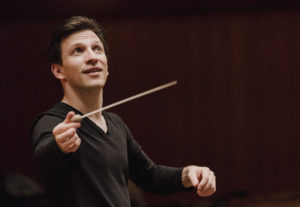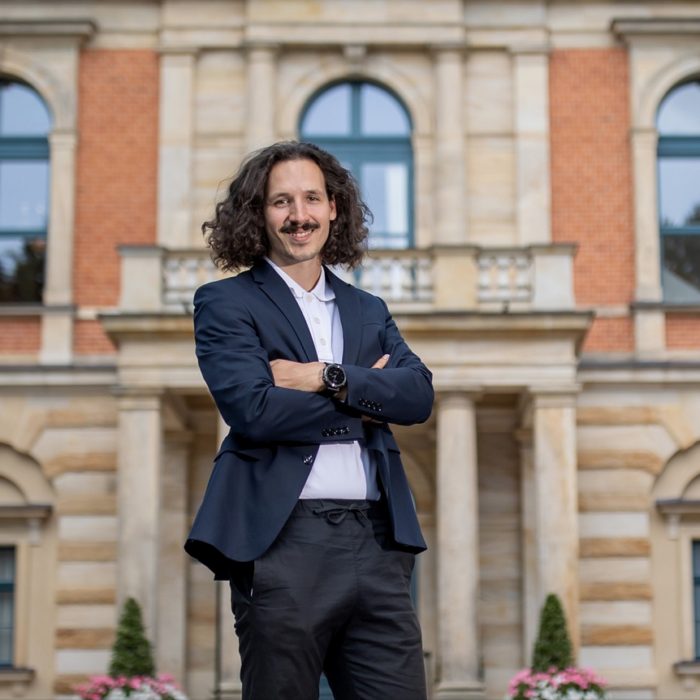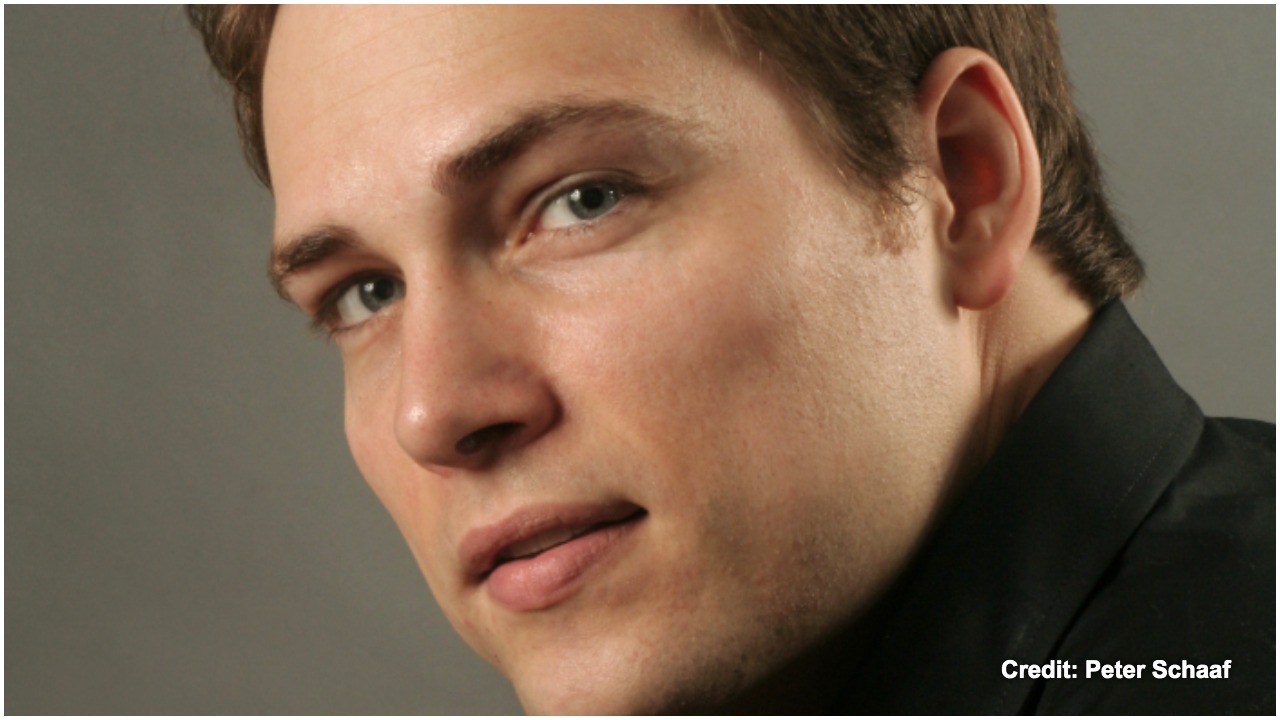
Q & A: Cornelius Meister on Staatsoper Stuttgart’s ‘A Day with Ariadne auf Naxos: In Search of Lost Closeness’
By Francisco Salazar(Credit: Marco Borggreve)
On April 11, the Staatsoper Stuttgart will present “A day with Ariadne auf Naxos: In Search of Lost Closeness.”
The interactive day will feature Cornelius Meister conducting Richard Strauss’ “Der Bürger als Edelmann” and “Ariadne auf Naxos” and a number of other interactive activities including interviews, a backstage tour, and a virtual foyer with artists and performers.
OperaWire spoke to Meister about Staatsoper Stuttgart’s initiatives, performing for a virtual audience and reconnecting with the company’s audience.
OperaWire: How have you been during this pandemic and what have you learned about yourself during this time?
Cornelius Meister: I wrote a book, improved my handstand skills, and have focused on historically informed performance practices. Bottom line, I have worked my fingers to the bone. My wonderful 1,400 colleagues at Staatstheater Stuttgart need an artistic director working for them day and night, especially in extraordinary times.
OW: The Staatsoper Stuttgart is streaming “Ariadne auf Naxos,” an opera that premiered with this company. Tell me about performing this work in Stuttgart and why it is a good work to stream during this time?
CM: “Musik ist eine heilige Kunst” (“Music is a holy art”) — this musical phrase sends shivers down my spine (sung by the mezzo-soprano singing the role of the Composer). It happens wherever I have conducted that opera whether at the Wiener Staatsoper, at the Glyndebourne Festival, at Staatsoper Stuttgart, or somewhere else. In Stuttgart, we are still using the original harmonium of the first performance in 1912 (!!) and have the old orchestra parts in our archive.
OW: What are some of the challenges of the score and what are some of your favorite moments?
CM: I am conducting this piece by heart since it is one of my Leib-und-Magen-Stücke — it’s in my soul. In my opinion, it consists only of favorite moments.
OW: Tell me about your cast and what has it been like to collaborate with them?
CM: Benjamin Bruns who has been one of the most brilliant Mozart and lighter Wagner tenors (Steuermann, David) is exploring heavier repertoire. One month before his debut as Bacchus at Bayerische Staatsoper, he will debut the role with us. An excellent artist! Simone Schneider (Ariadne), Beate Ritter (Zerbinetta), Pawel Konik (Harlekin) are outstanding fest members in Staatsoper Stuttgart’s ensemble which consists of about 40 singers. I spend a lot of my time as Music Director in rehearsals with them (playing those piano rehearsals by myself) so that we can be really proud when they are successful at La Scala, Opéra de Paris, Wiener Staatsoper, and the MET, too.
OW: Stuttgart is creating an all interactive day dedicated to Ariadne. Why do you think it is important to create these events and how do you think it brings you closer to the audience?
CM: In May 2020 our Prime Minister said, “If I missed something in particular during the last weeks, it was my grandchildren and the opera (“Wenn ich etwas in den vergangenen Wochen besonders vermisst habe, dann waren das meine Enkel und die Oper”).” Between April and July 2020, members of Staatsorchester Stuttgart played about 1000 (yes, one thousand) additional concerts. We played in front of the windows of kindergartens and retirement homes, we played in courtyards, we performed the operetta “Die Blume von Hawaii” at the Neckar river port. Just last month I told our Prime Minister that I am ready to play the whole “Ring des Nibelungen” on the piano — every scene for just five people belonging to one household. In every minute we are respecting many, many meters between all of us musicians (and follow state safety guidelines), so there has never been a corona infection during the work at Stuttgart Staatsoper and Staatsorchester. Our Ariadne of Naxos now is the next step collaborating with so many ensemble members and the orchestra.
OW: Having already done this with the Opernball, what kind of things did you see from the audience and do you think it made them feel closer to the theater?
CM: At the Opernball I spoke to visitors who had never visited the opera house before but since the Opernball was just one click away they dared to. In our last symphony concert two weeks ago many families started the concert together in front of their screens before the youngest went to bed while the elder kid(s) continued watching. This could never happen in analog concerts. In the break of the symphonic program, we had a Poetry Slam, and after the symphony, we continued with Jazz, Pop, and even a DJ. Nobody was forced to watch it but many did — the collaboration with all of these artistic facets within Stuttgart has strengthened our connections and, ultimately our community.
OW: Tell me about the Virtual foyer and how it works and how the artists will interact with the audience?
CM: Everybody in the world is invited to use his or her real name and their web-cam but no one is bound to do so. Therefore everybody has the chance to meet and speak with everybody in the Virtual foyer. Technically it is so easy, and it brings people from all over the world, all generations, opera lovers, and those experiencing opera for the first time together.
OW: As a conductor what are the challenges of conducting for a virtual audience and do you think events like this make you feel closer to your public?
CM: Before I moved to Staatsorchester Stuttgart, I had a wonderful eight years with the Vienna Radio Symphony from 2010 to 2018. There we were used to making a lot of studio recordings, not only audio but also video. So for me playing for microphones and cameras was not a new thing, not a Corona-related experience.
OW: Do you think these creative avenues are here to stay and how do you think these creative streams will be used once audiences are allowed to go back to the theater?
CM: Performances for an analog audience, for the radio, for a CD production, or for streaming: these are different artistic genres. However, I am convinced that we musicians living in the 21st century should use all of them. When at the end of the 19th century the car was invented many Germans (including the German Emperor) believed that cars would not prevail against horses. And think of the skepticism towards the internet just 25 years ago. So my credo is: Let’s be open to new experiences, achievements and technology, and new ways. They will not replace the good old ones but complement them.
OW: How will you view theater once it returns to normal and when you can finally interact with your audience?
CM: “Normality” should never be an aim for art, and actually I have interacted closely with our audience during the last thirteen months after my last performance before the pandemic (“Le nozze di Figaro” at the MET in February 2020): I visited school classes via zoom, I’ve explained Beethoven and Schubert symphonies and Bach’s St. John’s Passion in video conferences (answering numerous audience questions), I am in close contact with many politicians, not only associated with culture specifically but also those connected to the local community which I consider to be a matter of course for a Music Director. But I naturally long to perform for an audience in the hall, and I am working hard for that.
OW: Tell me quickly about the other Strauss work on the program, “Der Bürger als Edelmann.” Is there a defining moment in that piece for you?
CM: This piece is full of humor: a composed dinner menu, including salmon from the Rhine river, and it presents one of the most famous concertmaster solos in the “Dance of the Tailors” brilliantly played by Benjamin Bowman who joined Staatsorchester Stuttgart last December.


